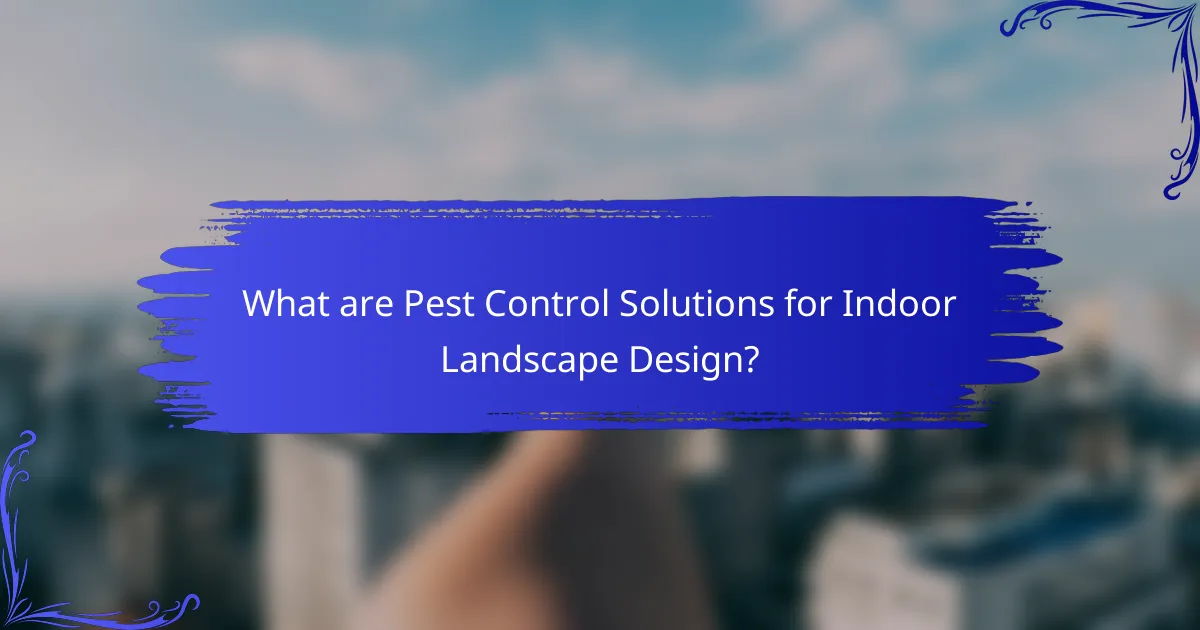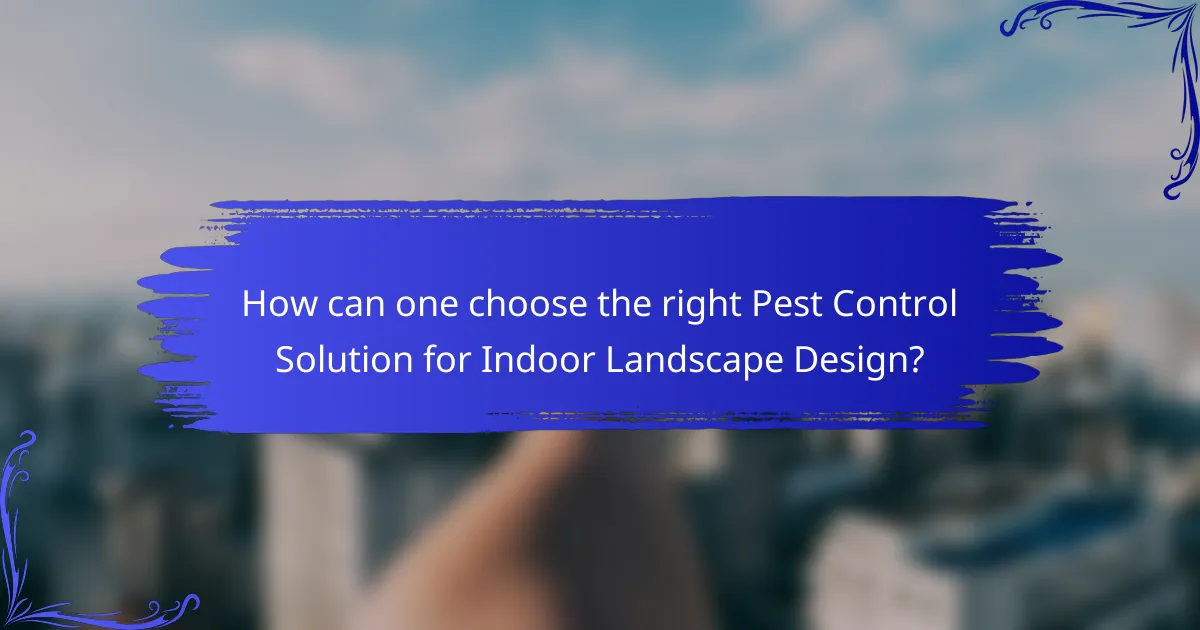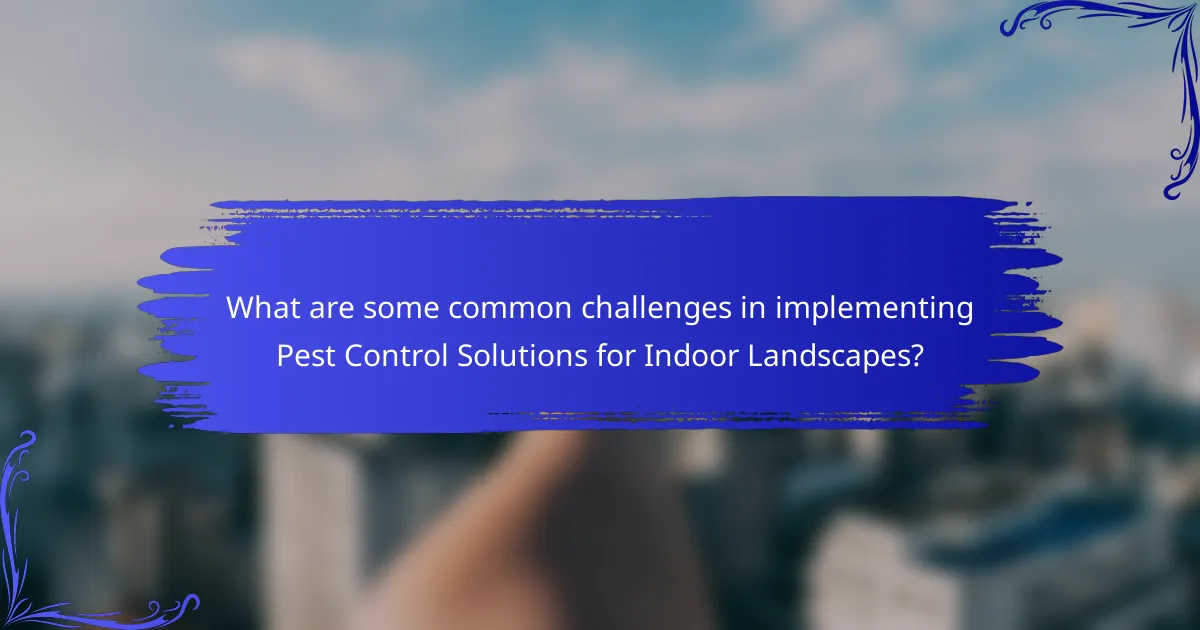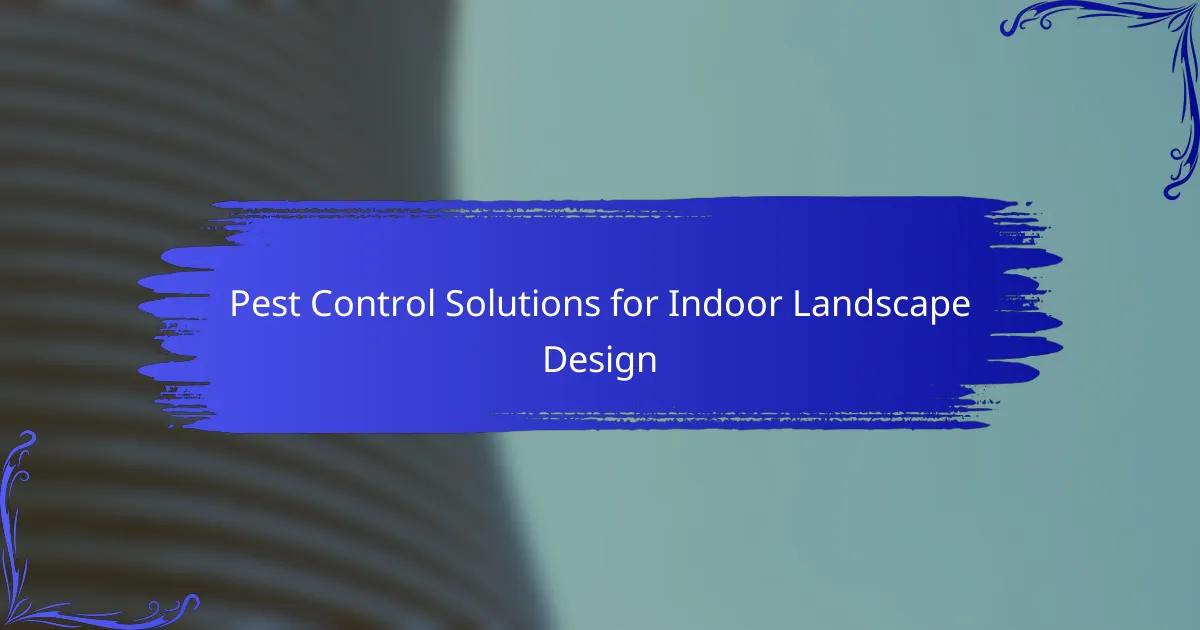Pest control solutions for indoor landscape design involve various methods to effectively manage pests that can harm plants. Integrated Pest Management (IPM) is a widely used approach that combines biological, cultural, physical, and chemical strategies. Key techniques include regular monitoring, the use of natural predators like ladybugs, and organic options such as neem oil. Challenges in implementing these solutions include limited access to treatment areas, environmental factors affecting pest behavior, and the need for compliance with regulations. Understanding specific pest types and selecting appropriate, safe solutions are essential for maintaining a healthy indoor environment for plants.

What are Pest Control Solutions for Indoor Landscape Design?
Pest control solutions for indoor landscape design include various methods to manage pests effectively. Integrated Pest Management (IPM) is a common approach. IPM combines biological, cultural, physical, and chemical tools. Regular monitoring of plants helps identify pest issues early. Natural predators, like ladybugs, can control aphid populations. Neem oil is a natural pesticide effective against many indoor pests. Sticky traps capture flying insects and monitor infestations. Maintaining proper humidity and temperature reduces pest attraction. Proper sanitation removes potential pest habitats and food sources. These solutions create a healthy indoor environment for plants.
How do Pest Control Solutions contribute to Indoor Landscape Design?
Pest control solutions enhance indoor landscape design by ensuring plant health and aesthetics. Healthy plants contribute to a visually appealing environment. Effective pest management prevents infestations that can damage or kill plants. Regular monitoring and treatment maintain the integrity of indoor landscapes. Studies show that well-maintained plants improve air quality and occupant well-being. Pest control measures also reduce the risk of disease transmission from pests to plants. Ultimately, these solutions support the longevity and vibrancy of indoor gardens.
What types of pests are commonly found in indoor landscapes?
Common pests found in indoor landscapes include aphids, spider mites, mealybugs, and fungus gnats. Aphids are small, soft-bodied insects that feed on plant sap. They can cause stunted growth and yellowing leaves. Spider mites are tiny arachnids that create webbing and can lead to leaf damage. Mealybugs are white, cottony pests that also suck sap and can weaken plants. Fungus gnats are small flies whose larvae feed on plant roots, causing poor growth. These pests can thrive in indoor environments due to favorable conditions like warmth and humidity. Regular monitoring and preventive measures are essential to manage these pests effectively.
How do pests impact the health of indoor plants?
Pests negatively impact the health of indoor plants by causing physical damage and transmitting diseases. They can feed on plant leaves, stems, and roots, leading to reduced photosynthesis and stunted growth. Common pests include aphids, spider mites, and mealybugs. Infestations can result in yellowing leaves, wilting, and even plant death if not managed. Pests also weaken plants, making them more susceptible to other stressors. Additionally, some pests can introduce pathogens that cause diseases, further compromising plant health. Regular monitoring and prompt intervention are essential to mitigate these effects.
Why is it important to implement Pest Control Solutions in Indoor Landscapes?
Implementing pest control solutions in indoor landscapes is crucial for maintaining plant health and aesthetics. Pests can cause significant damage to plants, leading to stunted growth and even death. This can compromise the overall design and intended ambiance of indoor spaces. Effective pest control helps prevent infestations that can spread quickly in enclosed environments. According to a study published in the Journal of Environmental Horticulture, proper pest management can increase plant survival rates by up to 30%. Additionally, pest control solutions can reduce the risk of allergens and diseases associated with pests. Maintaining a pest-free indoor landscape contributes to a healthier environment for occupants.
What are the potential risks of neglecting pest control in indoor settings?
Neglecting pest control in indoor settings can lead to significant health risks and property damage. Pests such as rodents and insects can spread diseases. For instance, rodents are known carriers of hantavirus and salmonella. Insects like cockroaches can trigger asthma and allergies. Additionally, pests can cause structural damage to buildings. Termites alone are responsible for billions in damages annually in the U.S. Furthermore, neglecting pest control can lead to infestations that are costly and difficult to eradicate. Regular pest management is essential for maintaining a safe and healthy indoor environment.
How can effective pest control enhance the aesthetic appeal of indoor landscapes?
Effective pest control enhances the aesthetic appeal of indoor landscapes by maintaining plant health and visual integrity. Healthy plants exhibit vibrant colors and lush foliage, contributing to an attractive environment. Pest infestations can lead to discoloration, wilting, and damage, detracting from the overall beauty. By implementing pest control measures, the risk of such damage is minimized. This proactive approach ensures that indoor landscapes remain visually appealing and inviting. Research shows that well-maintained indoor plants can improve mood and productivity, further emphasizing the importance of effective pest management in enhancing aesthetics.
What are the different types of Pest Control Solutions available for Indoor Landscapes?
There are several types of pest control solutions available for indoor landscapes. These solutions include chemical, biological, and physical methods. Chemical pest control involves the use of insecticides and pesticides to eliminate pests. Biological pest control utilizes natural predators or parasites to manage pest populations. Physical methods include traps, barriers, and sanitation practices to prevent pest infestations. Integrated Pest Management (IPM) combines these approaches for effective pest control. Each method has its own benefits and is selected based on the specific pest problem and environment.
What are chemical pest control methods and how do they work?
Chemical pest control methods involve the use of synthetic or natural chemicals to manage pest populations. These methods work by targeting specific pests through various modes of action. Insecticides, for example, disrupt the nervous system of insects, leading to paralysis or death. Herbicides target unwanted plants, inhibiting their growth or killing them outright. Fungicides are designed to eliminate fungal pathogens that can harm plants.
Chemical pesticides can be applied in different forms, including sprays, granules, or baits. The effectiveness of these methods often depends on proper application and timing. For instance, applying insecticides during peak pest activity increases their efficacy.
Regulatory guidelines exist to ensure the safe use of chemical pest control products. Many of these products undergo rigorous testing for safety and effectiveness before being approved for public use.
What are natural pest control methods and their benefits?
Natural pest control methods include biological control, cultural practices, and physical barriers. These methods utilize natural predators, habitat manipulation, and non-toxic barriers to manage pest populations. Biological control involves introducing beneficial insects, such as ladybugs, to prey on harmful pests. Cultural practices include crop rotation and proper sanitation to disrupt pest life cycles. Physical barriers, like row covers, prevent pests from accessing plants.
The benefits of these methods include reduced chemical usage, which minimizes environmental impact. They promote biodiversity by supporting beneficial organisms. Additionally, natural pest control methods can enhance soil health and improve plant resilience. Studies show that integrated pest management, which combines these methods, can lead to effective pest suppression while maintaining ecological balance.

How can one choose the right Pest Control Solution for Indoor Landscape Design?
To choose the right pest control solution for indoor landscape design, assess the specific pests affecting your plants. Identify whether the pests are insects, mites, or fungi. Select solutions that target these specific pests effectively. Consider the safety of the solution for indoor environments and plants. Organic options may be preferable for non-toxic applications. Evaluate the method of application, whether it is a spray, granule, or bait. Review the effectiveness and duration of the solution based on user reviews and product specifications. Research local regulations regarding pest control substances to ensure compliance.
What factors should be considered when selecting a pest control method?
When selecting a pest control method, several factors should be considered. First, the type of pest involved is crucial. Different pests require specific control strategies for effective management. Second, the environment where the pest control will be applied must be evaluated. Indoor spaces may have different requirements compared to outdoor settings.
Third, the safety of the method for humans and pets is essential. Non-toxic options are preferable in residential areas. Fourth, the method’s effectiveness and speed of action should be assessed. Some methods may take longer to show results.
Fifth, the cost of the pest control method is a significant factor. Budget constraints can influence the choice of treatment. Lastly, the potential impact on beneficial organisms should be considered. Certain methods may harm non-target species, affecting the ecosystem.
How does the type of plants influence the choice of pest control solution?
The type of plants significantly influences the choice of pest control solution. Different plants have varying sensitivities to pests and pest control methods. For example, some plants may be more susceptible to insecticides, while others can tolerate them. The life cycle and growth patterns of specific plants also dictate the timing and type of pest control needed. Additionally, the presence of beneficial insects can vary based on plant types, affecting the overall pest management strategy. Research indicates that certain plants can attract beneficial predators that naturally control pest populations. Therefore, understanding the specific needs and characteristics of the plants involved is crucial for selecting the most effective pest control solution.
What are the safety considerations for using pest control indoors?
Safety considerations for using pest control indoors include proper ventilation and the use of non-toxic products. Ensure that the area is well-ventilated to minimize inhalation of harmful chemicals. Always read and follow the manufacturer’s instructions for application and dosage. Keep children and pets away from treated areas until it is safe to return. Use personal protective equipment, such as gloves and masks, when handling pesticides. Store pest control products securely, out of reach of children. Dispose of any unused or expired products according to local regulations. Regularly monitor treated areas for any adverse reactions or pest resurgence.
How can pest control solutions be integrated into indoor landscape maintenance?
Pest control solutions can be integrated into indoor landscape maintenance through proactive monitoring and treatment strategies. Regular inspections of plants and soil help identify pest issues early. Integrated Pest Management (IPM) techniques can be employed to minimize chemical usage. Biological controls, such as introducing beneficial insects, can reduce pest populations naturally. Additionally, the use of organic pesticides can protect plants while being safe for indoor environments. Training staff on pest identification and management is essential for effective maintenance. Research shows that implementing IPM in indoor landscapes can reduce pest-related damage by up to 90%.
What are the best practices for monitoring pest activity in indoor landscapes?
The best practices for monitoring pest activity in indoor landscapes include regular inspections and the use of traps. Conduct inspections weekly to identify early signs of pest activity. Focus on areas like soil, foliage, and plant bases. Utilize sticky traps to capture flying insects and monitor their populations. Implement visual inspections to check for droppings or damage. Maintain a log of pest sightings and trap catches to track trends over time. Use a combination of physical, biological, and chemical monitoring methods for comprehensive assessment. This approach ensures timely intervention and effective pest management.
How often should pest control measures be applied in indoor settings?
Pest control measures should be applied in indoor settings every 1 to 3 months. Regular treatments help maintain a pest-free environment. The frequency can depend on the type of pests and the severity of the infestation. For example, high-risk areas may require monthly applications. Additionally, seasonal changes can influence pest activity. Research indicates that consistent monitoring and treatment reduce pest populations effectively. A study from the University of Florida highlights that proactive pest management leads to better outcomes than reactive measures.

What are some common challenges in implementing Pest Control Solutions for Indoor Landscapes?
Common challenges in implementing pest control solutions for indoor landscapes include limited access to treatment areas. This restricts the application of pesticides and other control methods. Additionally, environmental factors such as humidity and temperature can influence pest behavior and treatment effectiveness. The presence of sensitive plants also complicates the use of certain chemicals.
Moreover, maintaining a balance between pest control and plant health is crucial. This often requires specialized knowledge and careful planning. Resistance to pesticides can develop over time, making some solutions less effective. Finally, compliance with regulations regarding chemical use adds another layer of complexity.
What are the common misconceptions about pest control in indoor landscapes?
Common misconceptions about pest control in indoor landscapes include the belief that all pests can be eliminated with chemicals. Many people think that once treatment is applied, pests will not return. However, integrated pest management emphasizes prevention and monitoring rather than solely relying on pesticides. Another misconception is that indoor plants are immune to pests. In reality, indoor plants can attract various pests like aphids and spider mites. Additionally, some believe that natural remedies are always safe and effective. Research shows that not all natural solutions are harmless or effective against pests. Lastly, there is a misconception that pest control is only necessary during warmer months. Pests can thrive indoors year-round, making ongoing monitoring essential.
How can one effectively address resistance to pest control methods?
To effectively address resistance to pest control methods, implement an integrated pest management (IPM) approach. This strategy combines various control techniques to minimize reliance on any single method. Regular monitoring of pest populations is essential. This allows for timely interventions and reduces the chance of resistance developing.
Utilizing multiple control methods, such as biological, cultural, and chemical controls, enhances effectiveness. For instance, introducing natural predators can help manage pest populations without chemical reliance. Rotating different classes of pesticides can also prevent pests from developing resistance.
Education on proper application techniques is crucial. Misapplication can lead to increased resistance. Research indicates that IPM can reduce pest resistance by up to 50% when implemented effectively. Adapting strategies based on pest behavior and life cycles further optimizes pest control efforts.
What troubleshooting tips can help in managing pests in indoor landscapes?
Identify the type of pest present in the indoor landscape. Common pests include aphids, spider mites, and fungus gnats. Inspect plants regularly for signs of infestation. Look for discolored leaves, webbing, or visible insects. Maintain proper humidity and temperature levels. Pests thrive in conditions that are too humid or warm. Use insecticidal soap or neem oil as treatments. These are effective against many common indoor pests. Ensure good air circulation around plants. This helps prevent fungal infections and pest infestations. Remove dead leaves and debris promptly. This reduces hiding spots for pests. Quarantine new plants before introducing them to the indoor landscape. This prevents potential pest spread.
How can one identify early signs of pest infestations?
One can identify early signs of pest infestations by observing specific indicators. Common signs include droppings, which may appear as small pellets or streaks. Visible damage to plants, such as chewed leaves or wilting, often indicates pest activity. Additionally, an unusual presence of insects, like aphids or spider mites, can signal an infestation. Sticky residue on surfaces, known as honeydew, often results from pests feeding on plants. Furthermore, webbing on plants or corners can suggest spider infestations. Monitoring for these signs regularly helps in early detection. Early intervention is crucial to prevent significant damage to indoor landscapes.
What steps can be taken to prevent future pest problems in indoor landscapes?
To prevent future pest problems in indoor landscapes, implement a combination of proactive measures. First, maintain proper sanitation by regularly cleaning plant areas and removing debris. This reduces food sources for pests. Second, monitor plants frequently for early signs of pest activity. Early detection allows for timely intervention. Third, ensure proper watering practices to avoid overwatering, which can attract pests. Fourth, use pest-resistant plant varieties when possible. These plants are less susceptible to infestations. Fifth, apply physical barriers such as insect nets or sticky traps to deter pests. Finally, consider introducing beneficial insects that prey on common pests. These steps are effective in maintaining a healthy indoor landscape and minimizing pest issues.
Pest Control Solutions for Indoor Landscape Design encompass various methods aimed at effectively managing pests that threaten plant health and aesthetics. Key strategies include Integrated Pest Management (IPM), which combines biological, cultural, physical, and chemical tools for comprehensive pest control. The article details common indoor pests, their impacts on plant health, and the importance of regular monitoring and sanitation to prevent infestations. Additionally, it discusses the different types of pest control methods available, safety considerations, and best practices for maintaining a pest-free indoor environment, emphasizing the role of effective pest management in enhancing the overall appeal and longevity of indoor landscapes.
